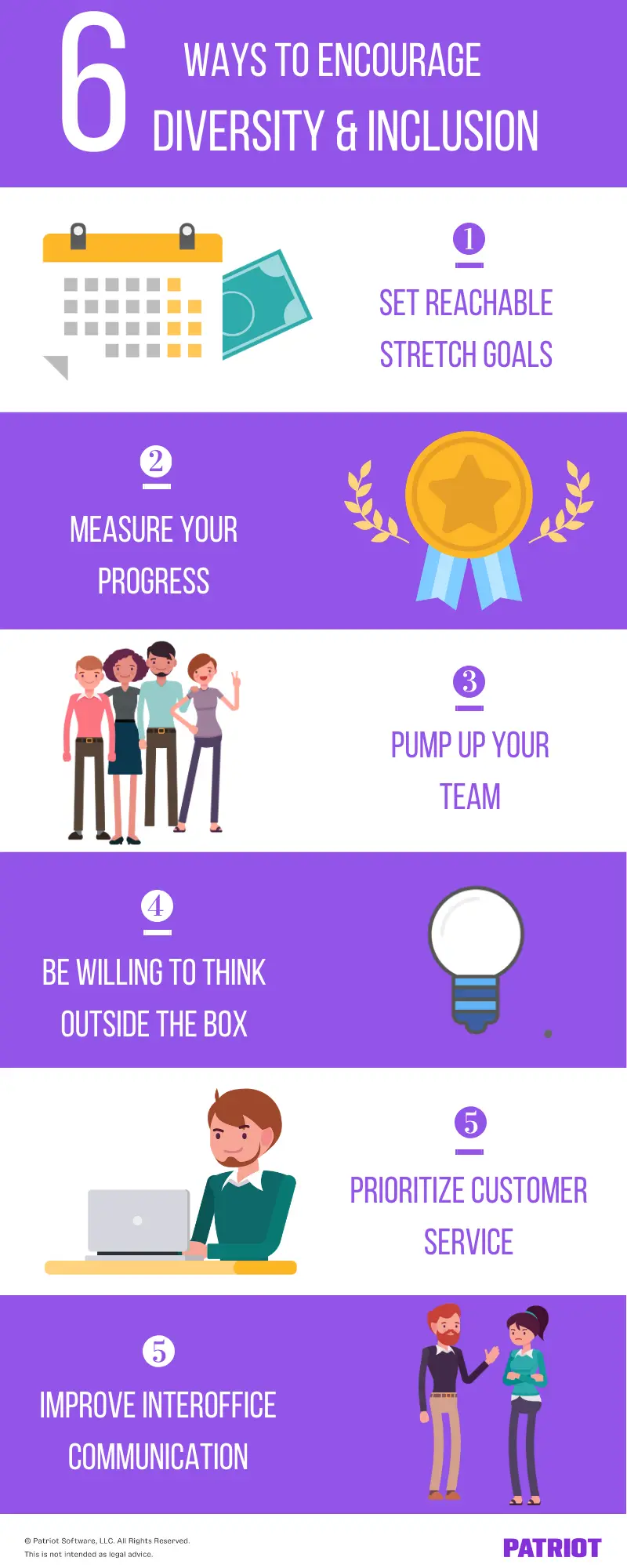According to a recent ZipRecruiter study, 86% of job seekers keep an eye out for workplace diversity when looking for a job. But candidates aren’t the only ones who value diversity and inclusion in the workplace—your current staff does, too.
If you want to foster a healthy, happy, and productive business environment, you need to focus on diversity and inclusion.
6 Ways to encourage diversity and inclusion in the workplace
First, let’s define diversity and inclusion. Diversity in the workplace is when you have employees with differences in things like background, gender, race, age, and religion. Inclusion in the workplace is the practice of cultivating a respectful and welcoming environment for all employees.
Take a look at six ways you can promote diversity and inclusion at work.

1. Create a fair hiring process
If you want to encourage diversity and inclusion in the workplace, you have to start at the top—the hiring process.
Joe Caccavale, content marketer at Applied, sheds some light on the problem of unconscious bias in the hiring process:
Initiatives to increase workplace diversity are often hindered by unconscious bias. Employers will make implicit assumptions about a person’s abilities based on their gender, age, ethnicity or class. Blind hiring can counter this, removing information such as a candidate’s name, gender, and date of birth to ensure the focus is on their skills and merit.”
Take a look at your current hiring process. Are you turning candidates away based on the questions you ask? There are certain questions you cannot ask during an interview because they could—intentionally or unintentionally—discriminate against job applicants.
From the initial job application to the interview process, you must create a hiring process that is inclusive to all job applicants. That way, you’ll avoid turning away applicants (and breaking discrimination laws in the process) and promote a diverse workplace.
2. Conduct a pay audit
Another way to encourage diversity and inclusion in the workplace is to make sure you’re paying your employees fairly. You can do this by conducting a pay audit.
A pay audit is an analysis of your employees’ pay in relation to factors like length of service, education, and performance evaluation scores. The purpose of a pay audit is to identify pay disparities.
So, what does a pay audit have to do with encouraging diversity and inclusion at work? In short, everything. You can’t expect to cultivate a culture of diversity if you have discriminatory pay practices.
And if you do find that you’re paying an employee a lower wage than an equivocal employee without reason, get ready to make some changes.
3. Provide equal opportunities
In addition to paying employees fairly, you also need to provide them equal opportunities. A diverse and inclusive environment thrives on having a range of people in various roles.
Every employee should have an equal opportunity to move up the career ladder. If you have a homogenous team of managers or other leaders, you may need to take another look.
Make sure all employees know how they can advance their career and develop their skills. Don’t reserve opportunities for a select few employees who are in-the-know.
Another way you can give your employees equal opportunities is by accommodating their diverse needs. For example, you may have an employee who needs religious accommodation and another who needs reasonable accommodation.
4. Put it in writing
Only a little more than half of people (55%) agree that their organization has policies promoting diversity and inclusion. Does yours?
If you don’t have a policy outlining your business’s stance on equal opportunities, accommodations, and harassment, now’s the time.
Your policy on diversity- and inclusion-related topics shouldn’t be tucked away for nobody to see. Include a copy in your employee handbook so all employees can hold you and each other accountable.
5. Prioritize training
Of course, once you have policies and practices in place showing your dedication to diversity and inclusion, you should share it with your team in-person, too. You can do this by prioritizing orientation and training.
Orientation sessions should go over what you expect from new hires and what they should expect from you and their new co-workers.
Consider having regular training sessions so nobody forgets how to behave in the workplace. And, you can have emergency training sessions in response to incidents (e.g., harassment).
6. Take swift action
Forty-five percent of U.S. workers said they experienced discrimination or harassment within the past 12 months. If this is going on in your workplace, take swift action to put an end to it.
Again, you can have a company-wide meeting to talk about how you expect employees to act. But, you also need to take action with both the victim of discrimination or harassment as well as the one who caused the issue.
Depending on the severity of the issue, you may need to re-explain your business’s policies, administer strikes, or even terminate the employee causing the problem.
Whatever response is warranted, make sure to do something as soon as you catch wind of a situation.



